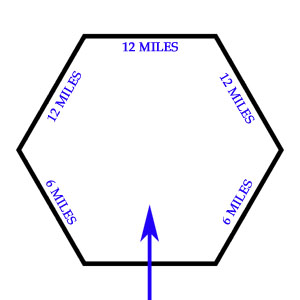Hexploration/Old full rules
See Hexploration
Full rules
Watches
A watch is the basic unit for tracking time. A watch is equal to 4 hours.
Determine Time Within a Watch: To randomly generate a particular time within a watch, use 1d8 to determine the half hour and 1d30 to determine the exact minute (if necessary).
There are six watches per day and three types of watch:
- Active
- Rest
- Travel
While traveling, it is generally assumed that an expedition is spending two watches per day traveling, two watches per day resting, and two watches per day engaged in other activities.
Forced March: If a character spends more than two watches traveling in one day, they must make a Constitution check (DC 10 + 1 per hour of additional travel). On a failure, they suffer one level of exhaustion/fatigue.
Travel Pace
During each watch, the expedition determines their travel pace.
Normal: (x1) An expedition traveling at normal pace cannot use Stealth checks to avoid detection.
Slow: (x2/3) While moving at a slow pace, the expedition is purposely being careful. An expedition traveling at slow pace:
- Gains advantage on navigation checks.
- Can make Stealth checks to avoid detection.
- The chance for a non-exploratory encounter is halved. (If a non-exploratory encounter is generated, there is a 50% chance it doesn’t actually happen.)
Exploration: (x1/2) While exploring, an expedition is assumed to be trying out side trails, examining objects of interest, and so forth. While exploring, an expedition:
- Cannot use Stealth checks to avoid detection.
- Gains advantage (PF2 = +5 circumstance bonus) on navigation checks.
- The chance for encounters is doubled.
Fast: (x1.5) While moving quickly through the wilderness, expeditions traveling at fast pace:
- Cannot use Stealth checks to avoid detection.
- Suffer disadvantage to Wisdom (Perception) checks.
- Suffer a -5 penalty to navigation checks.
The most common speed is 30ft, 3mph, 12 miles per watch, 24 miles per day.
| Speed | Feet per Minute | Miles per Hour | Miles per Day |
| 10 | 100 | 1 | 8 |
| 15 | 150 | 1-1/2 | 12 |
| 20 | 200 | 2 | 16 |
| 25 | 250 | 2-1/2 | 20 |
| 30 | 300 | 3 | 24 |
| 35 | 350 | 3-1/2 | 28 |
| 40 | 400 | 4 | 32 |
| 50 | 500 | 5 | 40 |
| 60 | 600 | 6 | 48 |
Terrain
The type of terrain modifies the speed at which an expedition can travel.
- Highway: A highway is a straight, major, paved road.
- Road: A road is a dirt track or similar causeway.
- Trail: An irregular byway. Probably unsuitable for most vehicles and may only allow for single-file travel. Most off-road travel follows local trails. A known trail does not require navigation checks, although a known trail in poor repair requires a DC 10 navigation check to follow.
- Trackless: Trackless terrain is a wild area with no paths. +2 to navigation DCs.
| TERRAIN | |||||
|---|---|---|---|---|---|
| Desert | |||||
| Forest (sparse) | |||||
| Forest (medium) | |||||
| Forest (dense) | |||||
| Hills | |||||
| Jungle | |||||
| Moor | |||||
| Mountains | |||||
| Plains | |||||
| Swamp | |||||
| Tundra, frozen |
Note! These DCs are for e and ma have to be revised for PF2
Conditions
| CONDITIONS | |
|---|---|
| Cold or hot climate | |
| Giant terrain | |
| Hurricane | |
| Leading mount | |
| Poor visibility (fog, darkness) | |
| River crossing | |
| Snow cover | |
| Snow cover, heavy | |
| Storm | |
| Storm, powerful |
Leading Pack Animal: Under normal circumstances, a pack-puller can lead a file with a number of animals equal to their passive Wisdom (Animal Handling) skill.
Poor Visibility: This condition also gives disadvantage to navigation and forage checks.
River Crossing: This penalty applies to any watch during which a river must be crossed. This does not apply if the characters are following a road which has a bridge on it, but does apply if they’re traveling cross-country and must seek out a bridge.
Hexes
- 1 Hex = 12 miles (center to center / side to side) = 7 mile sides = 124 square miles
Movement on the wilderness hex grid is abstracted. In order to determine if an expedition has left a hex, you must keep track of their progress within the hex.
Starting in a Hex: If an expedition starts movement within a hex, it requires 6 miles of progress to exit any face of the hex.
- Optional Rule: You can choose to bias a starting position. For example, you might see that a river flows near the western edge of a hex. If the PCs start traveling from that river, you might decide it only takes 2 miles to exit through the hex’s western face and 10 miles to exit through its eastern face.
Crossing Hex to a Far Side: It requires 12 miles of progress to exit a hex through one of the three faces on the opposite side.
Crossing Hex to a Near Side: It requires 6 miles of progress to exit a hex through one of the two nearest faces.
Changing Direction: Changing direction more than once within a hex will result in the loss of 2 miles of progress each time direction is changed.
Back the Way We Came: If characters deliberately double back along their own trail, simply reduce their progress until they exit the hex. If they leave back through the face through which they entered the hex for any other reason (by getting lost, for example) it requires an additional 1d6-1 miles of progress to exit the hex (unless circumstances suggest some other figure).
Watch Actions
